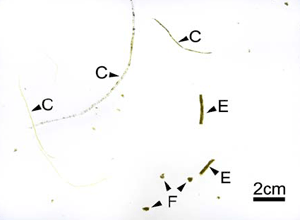Growth of giant tiger prawn under co-culture with Chaetomorpha ligustica at aquarium scale
Description
Over the past two decades, the giant tiger prawn, Penaeus monodon Fabricius, has become an important aquatic export product for Southeast Asian countries. In Thailand, which has pioneered the intensive giant tiger prawn culture, production was valued at 15.1 billion Thai Baht (1 THB = 0.024 USD: 2000) in 2000 (Fisheries Information Technology Center 2006). However, prawn aquaculture has generated some negative impacts, such as environmental deterioration, eutrophication, and frequent outbreaks of bacterial and viral diseases. Declining prawn growth rate is also a major problem. Thus, the production of intensively cultured prawns can lead to a number of difficulties in the producer countries.
We have been developing a closed co-culture system of giant tiger prawn and seaweeds since 2004, which is simple, low-cost, with low negative environmental impact and can be operated by small-scale shrimp farmers. In our co-culture system, we encourage the growth of Chaetomorpha ligustica (Kützing) Kützing, which consists of dark green to yellowish brown thin filaments that are unbranched series of cylindrical cells. This alga is abundant in aquaculture ponds and irrigation canals in the brackish water areas in Thailand. This plant is ordinarily removed and discarded from rearing ponds by shrimp farmers since they believe that shrimp growth is suppressed when it is abundant. Baliao & Tookwinas (2002) recommended the removal of floating masses of benthic and filamentous algae. However, this seaweed may in fact have the function of being an absorber of toxic substances and as part of the diet of co-cultured prawns in our system. The objective of this study was to investigate the dietary effect of this discarded filamentous seaweed on the growth of giant tiger prawn juveniles.
The growth of the juvenile giant tiger prawn was evaluated at aquarium scale in co-culture with Chaetomorpha ligustica (Kützing) Kützing. Juveniles at different ages in days were examined, designated J 16, J 44, J 58, J 93 and J 128, where a 1-day-old juvenile (J 1) is equivalent to a 20-day-old post-larva (PL 20). Culture experiments for each age group were conducted over a period of 7 days. Juveniles at every age group grazed directly on live C. ligustica, even those fed an artificial shrimp diet to satiation (Fig.1).
Excreta of the juvenile in each container were carefully collected and examined under a stereo microscope (Fig. 2). Mean chlorophyll a levels in the excreta of mono-culture groups (controls) were low but stable. Levels in co-culture with seaweed groups (treatments), in contrast, were approximately 20–50 times higher than in the controls (Fig 3). Mean specific growth rate (SGR: % day–1) of treatment groups was higher in early-age juveniles (Fig.4). Compared to mono-culture, significant differences in growth were observed at J 16 (4.44% day–1) and J 44 (1.60% day–1); however, no significant differences were recorded at J 58 (1.16% day–1), J 93 (0.75% day–1) or J 128 (0.45% day–1). It was concluded that co-culture of giant tiger prawn with C. ligustica has a dietary advantage, especially in early-age juveniles.
Figure, table
-
Fig. 1. A giant tiger prawn in a co-culture pond with the algae. Juveniles at every age group grazed directly on live C. ligustica -
Fig. 2. Stereomicrograph of Chaetomorpha ligustica (C), excreta (E) and uneaten food particles (F). -
Fig. 3. Chlorophyll a (µg mg–1) concentration in excreta of giant tiger prawn juveniles of different age groups
: mono-cultured (open bars) and co-cultured with Chaetomorpha ligustica (solid bars). Results are given as mean (S.E.) for five juveniles in each group. * P < 0.05, ** P < 0.01. -
Fig. 4. Specific growth rates (SGR, % day–1) of giant tiger prawn juveniles of different age groups
: mono-cultured (open bars) and co-cultured with Chaetomorpha ligustica (solid bars). Results are shown as mean (S.E.) for five juveniles in each group. *P < 0.05, NS: not significant.
- Affiliation
-
Japan International Research Center for Agricultural Sciences Fisheries Division
- Classification
-
Administration B
- Term of research
-
FY2009(FY2006~2010)
- Responsible researcher
-
HAMANO Kaoru ( Fisheries Division )
Tsutsui Isao ( Fisheries Division )
KAKEN Researcher No.: 80425529SRISAPOOME Prapansak ( Kasetsart University )
Aue-umneoy Dusit ( King Mongkut's Institute of Technology Ladkrabang )
- ほか
- Publication, etc.
-
https://doi.org/10.1007/s10499-009-9274-2
Tsutsui et al. (2009) Aquaculture International 17
- Japanese PDF
-
2009_seikajouhou_A4_ja_Part12.pdf247.22 KB




